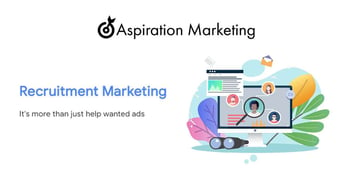5 Ways to Measure Recruitment Marketing ROI
Often, the concepts and principles of recruitment marketing and employer branding frameworks make sense on paper and sound extremely attractive to talent acquisition managers and specialists because they demonstrate an acumen with technology and current thought leadership to candidates. But today's recruitment teams are more than likely driven by one single word: Data.
Data tells a story, reporting drives action and analytics push how recruitment teams deploy strategies or tactics in applicant sourcing. This means that proving return on investment in recruitment marketing and employer branding must be defined and communicated for recruiters to understand the value proposition in continuing to engage job seekers in a marketing-driven way.
But what are the critical metrics in recruitment marketing? How can today's recruitment specialists understand ROI? What data points should recruitment teams look to as proof of concept? With these questions in mind, let's examine five ways to measure ROI in recruitment marketing.
Time to hire
Perhaps paramount in a recruiter's dashboard (perhaps overcome by one metric we'll discuss in a moment) is the time to hire or accept, depending on your industry and company's verbiage. Regardless, we're talking simply about the number of days that elapse from posting a job vacancy, engaging in recruitment strategy, and having a candidate accept an offer. In terms of a marketing funnel, think of time to hire in the same realm as the buyer's journey – the time from when a visitor to your blog or website became a lead, was nurtured, and then finally turned into a conversion via closing the deal of a sale.
It's a simple question: Did a recruitment marketing strategy for a specific position in a specific market with a specific amount of resources allocated for the campaign result in a shorter time to hire than a similar position in a similar market without a recruitment marketing strategy?
That's the question a recruitment specialist needs to answer to evaluate whether recruitment marketing effectively impacts the hiring time.
Cost per hire
As referenced above, the cost per hire is perhaps the only metric that can dwarf time to hire, especially given the restraints, constrictions, and increased agility companies across the board are facing. The elements that factor into cost per hire can vary by industry, but essentially you're looking at:
-
Promoting the position on job boards like Indeed
-
Utilizing outside search firms
-
Leveraging a temp agency to fill a position while a long-term candidate is found
-
Other methods of outreach and engagement include posting a position to a professional organization or using a third party to help funnel applications or mailing lists.
The costs of these avenues can range based on the depth at which recruiters deploy them. As with our time-to-hire example, it's imperative to judge the ROI of recruitment marketing in an apples-to-apples fashion. You can't judge how a recruitment marketing strategy fared with a highly-skilled position in a very competitive marketing compared with an entry-level position in a feast-and-famine market.
If all things are equal and your cost per hire decreases when you execute a recruitment marketing strategy, you have the ammunition you need regarding proof of concept.
Social media engagement
While the first two ROI metrics relate directly to recruitment, analytics, and reporting regarding social media help directly prove how well job seekers receive your employer brand, narrative, and messaging – both passive and active job seekers. The key data points are impressions (how many viewed your content), engagement (how many people liked, shared, commented on, or otherwise interacted with your content), and your amount of spend per boosted post or ad, particularly on sites like Facebook and Instagram, but also on platforms such as Twitter and LinkedIn.
In addition, regarding Twitter, another valuable metric is re-tweets or how often your Tweet was copied and Tweeted on other users' profiles. And, hey, if you can get your content trending (as long as it's positive), you're most likely golden in reaching the maximum number of eyeballs with your employer branding.
But social media platforms like Facebook can also help evaluate how effective content is regarding recruitment. The number of link clicks on a particular post (mainly if you drive traffic back to a specific job post or landing page) can also help you better understand the number of job seekers engaged with your social content and job posting.
Web traffic
Like the social media engagement metrics, evaluating your web traffic reporting relative to your company's main website, individual landing pages, pillar pages, and other digital destinations are other KPIs to consider when examining your employer branding strategy's strength, depth, and reach. The same is, of course, true if part of your recruitment branding strategy includes a blog (how many hits, clicks on links in your blog post, and the amount of time visitors stay on individual posts), and these data points can also help drive editorial decisions in terms of the content you publish. If specific entries drive higher traffic rates than others, your visitors signal the content that matters most to them.
Part and parcel to web traffic analytics are video views via your YouTube page or another third-party video housing service integrated with your website.
Brand awareness
What search terms are job seekers using to find you? Whether via a search engine like Google or a job board like Indeed, closer and more specific job seekers are searching for you by brand. The brand alone is a good indicator of whether your employer brand via recruitment marketing is strong or needs attention.
How large is your social media following? How many contacts do you have via email marketing campaigns? How many unique visitors do you have to your website instead of returning visitors? These metrics are critical in measuring ROI in recruitment marketing and overall employer branding frameworks and strategies.








Leave a Comment